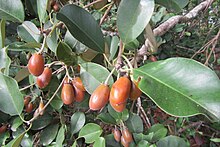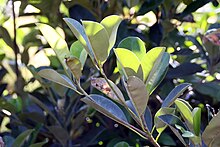| Manilkara kauki | |
|---|---|

| |
| Fruits and foliage | |

| |
| Leaves | |
| Scientific classification | |
| Kingdom: | Plantae |
| Clade: | Tracheophytes |
| Clade: | Angiosperms |
| Clade: | Eudicots |
| Clade: | Asterids |
| Order: | Ericales |
| Family: | Sapotaceae |
| Genus: | Manilkara |
| Species: | M. kauki |
| Binomial name | |
| Manilkara kauki (L.) Dubard | |
| Synonyms | |
Manilkara kauki is a plant in the subfamily Sapotoideae, and the tribe Sapoteae of the family Sapotaceae; and is the type species for the genus Manilkara. It occurs in tropical Asia from Indo-China (Cambodia, Myanmar, Thailand and Vietnam) to Malesia (Indonesia, Malaysia and Papua New Guinea); and also in northern Queensland in Australia.
It is rarely planted commercially but as an ornamental plant.
Names
Throughout the world it is known generally by the name caqui, but in Australia it is called wongi. In Java, the plant is called sawo kacik. The fruit is called adão (Adam’s fruit) in Konkani.
Description
| This section needs expansion. You can help by adding to it. (May 2024) |
Its leaves are rigid and have blunt tips, its upper surfaces are dark green while pale and silky underneath.
Its fruiting season is from December to February, it produces edible ovoid fruit that turns dark orangish red when ripe, each are 2.5–5.32 cm long and 2 cm wide with a smooth pale brown seed inside.
Uses
The fruit is reported to be very tasty, and is traditionally eaten by Torres Strait Islanders, who travel from island to island to harvest the crop. Members and servants of Javanese royal families plant them in palace gardens as a symbol of kindness and loyalty.
It often grows wild in forests attracting birds and primates. For reforestation purposes, M. kauki is a useful graft stock for M. zapota, and parts of the plant are used in herbal medicine.
References
- Annales du Musée Coloniale de Marseille ser. 3, 3 1915 "Plant Name Details for Manilkara kauki". Retrieved 30 December 2009.
basionym: Sapotaceae Mimusops kauki L.
- "Manilkara kauki (L.) Dubard". Plants of the World. Royal Botanic Gardens, Kew. 2024. Retrieved 18 May 2024.
- ^ "Manilkara kauki". Germplasm Resources Information Network. Agricultural Research Service, United States Department of Agriculture. Retrieved 30 December 2009.
- Species Plantarum 2 1753 "Plant Name Details for Mimusops kauki". Retrieved 30 December 2009.
Type Information: "Habitat in Zeylona." basionym of: Sapotaceae Manilkara kauki
- ^ Nur Nadiah Md Yusof; Siti Khairiyah Mohd Hatta; Faezah Pardi; Asmida Ismail (2022). Garis Panduan Penanaman Makanan Hidupan Liar (in Malay). Kuala Lumpur, Malaysia: Department of Wildlife and National Parks Peninsular Malaysia. ISBN 978-967-5557-36-1 – via FlipHTML5.
- Low, T. (1988). Wild Food Plants of Australia. Angus & Robertson. ISBN 978-0-207-16930-4.
- ^ Armstrong, K. E. (February 2013). "A Revision of the Asian-Pacific species of Manilkara (Sapotaceae)". Edinburgh Journal of Botany. 70 (1): 7–56. doi:10.1017/S0960428612000327.
| Taxon identifiers | |
|---|---|
| Manilkara kauki |
|
| Mimusops kauki | |
This Sapotaceae article is a stub. You can help Misplaced Pages by expanding it. |
This fruit-related article is a stub. You can help Misplaced Pages by expanding it. |
This Australian asterid article is a stub. You can help Misplaced Pages by expanding it. |